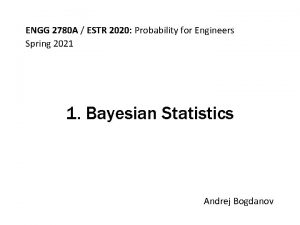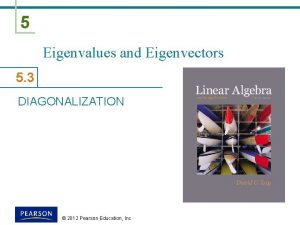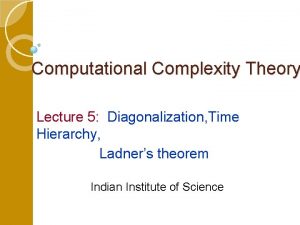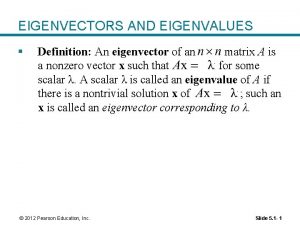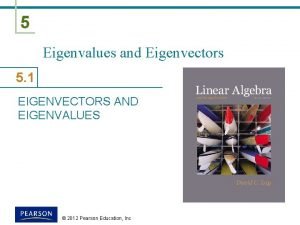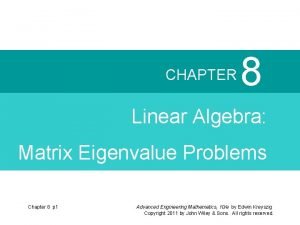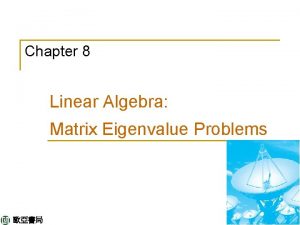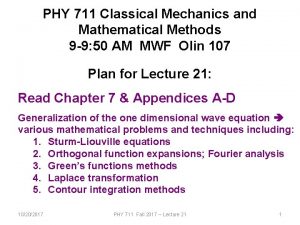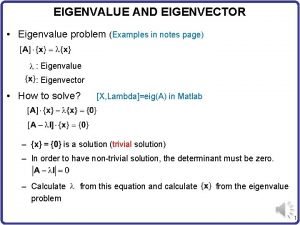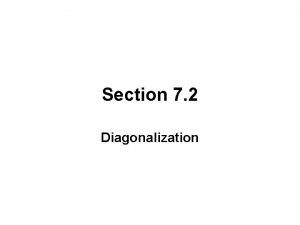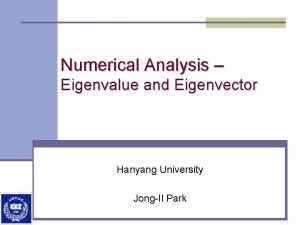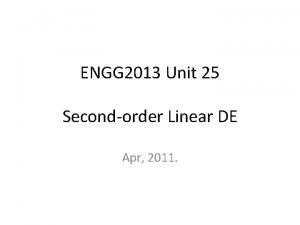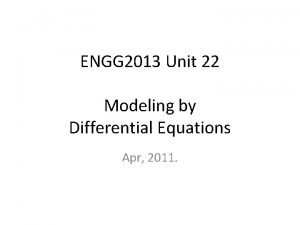ENGG 2013 Unit 17 Diagonalization Eigenvector and eigenvalue































- Slides: 31

ENGG 2013 Unit 17 Diagonalization Eigenvector and eigenvalue Mar, 2011.

EXAMPLE 1 kshum ENGG 2013 2

Q 6 in midterm • u(t): unemployment rate in the t-th month. • e(t)= 1 -u(t) • The unemployment rate in the next month is given by a matrix multiplication • Equilibrium: Solve Unemployment rate at equilibrium = 0. 2 kshum ENGG 2013 3

Equilibrium Unstable kshum Stable ENGG 2013 4

If stable, how fast does it converge to the equilibrium point? Slow convergence 0. 2 kshum Fast convergence 0. 2 ENGG 2013 5

Question • Suppose that the initial unemployment rate at the first month is x(1), (for example x(1)=0. 25), and suppose that the unemployment evolves by matrix multiplication Find an analytic expression for x(t), for all t. kshum ENGG 2013 6

EXAMPLE 2 kshum ENGG 2013 7

How to count? • Count the number of binary strings of length n with no consecutive ones. kshum ENGG 2013 8

SOLVING RECURRENCE RELATION kshum ENGG 2013 9

• • F 1 = 1 F 2 = 1 For n > 2, Fn = Fn-1+Fn-2. The Fibonacci numbers are – 1, 1, 3, 5, 8, 13, 21, 34, 55, 89, 144 kshum ENGG 2013 http: //en. wikipedia. org/wiki/Fibonacci_number Fibonacci numbers 10

A matrix formulation • Define a vector • Initial vector • Find the recurrence relation in matrix form kshum ENGG 2013 11

A general question • Given initial condition and for t 2 Find v(t) for all t. kshum ENGG 2013 12

Matrix power • Need to raise a matrix to a very high power kshum ENGG 2013 13

A trivial special case • Diagonal matrix • The solution is easy to find • Raising a diagonal matrix to the power t is easy. kshum ENGG 2013 14

Decoupled equations • When the equation is diagonal, we have two separate equation, each in one variable kshum ENGG 2013 15

DIAGONALIZATION kshum ENGG 2013 16

Problem reduction • A square matrix M is called diagonalizable if we can find an invertible matrix, say P, such that the product P– 1 M P is a diagonal matrix. • A diagonalizable matrix can be raised to a high power easily. – Suppose that P– 1 M P = D, D diagonal. – M = P D P– 1. – Mn = (P D P– 1) … (P D P– 1) = P Dn P– 1. kshum ENGG 2013 17

Example of diagonalizable matrix • Let • A is diagonalizable because we can find a matrix such that kshum ENGG 2013 18

Now we know how fast it converges to 0. 2 • The matrix can be diagonalized kshum ENGG 2013 19

Convergence to equilibrium • The trajectory of the unemployment rate – the initial point is set to 0. 1 kshum ENGG 2013 20

EIGENVECTOR AND EIGENVALUE kshum ENGG 2013 21

How to diagonalize? • How to determine whether a matrix M is diagonalizable? • How to find a matrix P which diagonalizes a matrix M? kshum ENGG 2013 22

From diagonalization to eigenvector • By definition a matrix M is diagonalizable if P– 1 M P = D for some invertible matrix P, and diagonal matrix D. or equivalently, kshum ENGG 2013 23

The columns of P are special • Suppose that kshum ENGG 2013 24

Definition • Given a square matrix A, a non-zero vector v is called an eigenvector of A, if we an find a real number (which may be zero), such that Matrix-vector product Scalar product of a vector • This number is called an eigenvalue of A, corresponding to the eigenvector v. kshum ENGG 2013 25

Important notes • If v is an eigenvector of A with eigenvalue , then any non-zero scalar multiple of v also satisfies the definition of eigenvector. k 0 kshum ENGG 2013 26

Geometric meaning • A linear transformation L(x, y) given by: L(x, y) = (x+2 y, 3 x-4 y) x x + 2 y y 3 x – 4 y • If the input is x=1, y=2 for example, the output is x = 5, y = -5. kshum 27

Invariant direction • An Eigenvector points at a direction which is invariant under the linear transformation induced by the matrix. • The eigenvalue is interpreted as the magnification factor. • L(x, y) = (x+2 y, 3 x-4 y) • If input is (2, 1), output is magnified by a factor of 2, i. e. , the eigenvalue is 2. kshum 28

Another invariant direction • • L(x, y) = (x+2 y, 3 x-4 y) If input is (-1/3, 1), output is (5/3, -5). The length is increased by a factor of 5, and the direction is reversed. The corresponding eigenvalue is -5. kshum 29

Eigenvalue and eigenvector of First eigenvalue = 2, with eigenvector where k is any nonzero real number. Second eigenvalue = -5, with eigenvector where k is any nonzero real number. kshum ENGG 2013 30

Summary Motivation: want to solve recurrence relations. Formulation using matrix multiplication Need to raise a matrix to an arbitrary power Raising a matrix to some power can be easily done if the matrix is diagonalizable. • Diagonalization can be done by eigenvalue and eigenvector. • • kshum ENGG 2013 31
 Eigenvalue from eigenvector
Eigenvalue from eigenvector Diagonalizable matrix
Diagonalizable matrix Engg 2780
Engg 2780 Civil house drawing
Civil house drawing Engg 1100
Engg 1100 Engg 1100
Engg 1100 Diagonalization of matrix
Diagonalization of matrix The complement of halting problem is not enumerable.
The complement of halting problem is not enumerable. Distinct eigenvalues
Distinct eigenvalues Uncountable set examples
Uncountable set examples Diagonalization method in theory of computation
Diagonalization method in theory of computation Diagonalization language
Diagonalization language Eigenvector definition
Eigenvector definition Eigenvalue definition
Eigenvalue definition Eigenvector
Eigenvector Eigenvectors
Eigenvectors Eigenvalue of 2x2 matrix
Eigenvalue of 2x2 matrix Skew symmetric matrix
Skew symmetric matrix Orthogonal matrix example 3x3
Orthogonal matrix example 3x3 Power method smallest eigenvalue
Power method smallest eigenvalue Eigenvalue
Eigenvalue Imageprocessingplace
Imageprocessingplace Eigenvalue examples
Eigenvalue examples Slides mani
Slides mani Unit 10, unit 10 review tests, unit 10 general test
Unit 10, unit 10 review tests, unit 10 general test Ertmer and newby 2013
Ertmer and newby 2013 Coso 2013 internal control framework
Coso 2013 internal control framework Hyp opp adj
Hyp opp adj Unit process and unit operation
Unit process and unit operation Difference between unit process and unit operation
Difference between unit process and unit operation Ytv 2012
Ytv 2012 Lembar pengesahan dokumen 1 kurikulum 2013
Lembar pengesahan dokumen 1 kurikulum 2013


